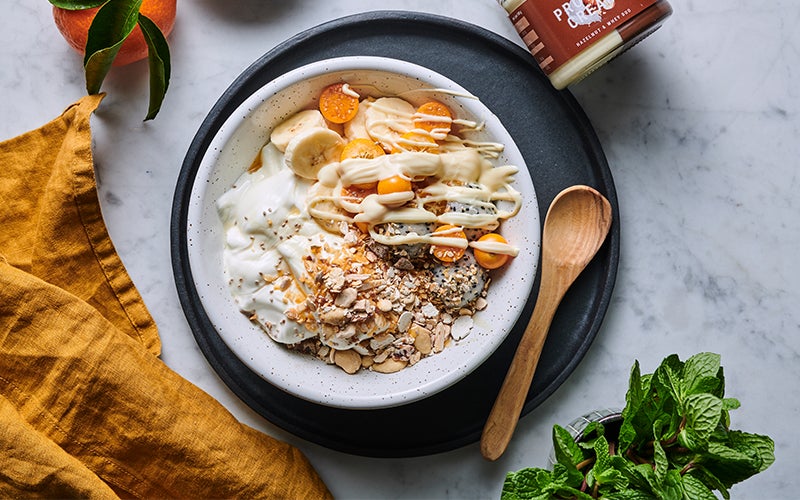8 Diets To Fit Your Body
 ©foodspring
©foodspring
It’s a good news-bad news situation: there are a ton of diets these days. How do you know which one is right for you? It depends on what your goals are, what your lifestyle’s like, and what food systems you want to participate in. Here, we’ve outlined 8 diets to give you an idea of what’s out there.
1) High Protein Diet: Fill up on protein throughout the day
A protein diet is exactly what it sounds like: lots and lots of protein with every meal. It’s an especially ideal eating plan for anyone interested in building muscle, but it can be a boon for weight loss as well.
What foods does this diet include?
The rules are right in the name. While many choose to focus on incorporating more animal-based products in order to supplement protein, there are plenty of plant-based protein alternatives that are ideal for anyone on a vegan or vegetarian diet. Here are some protein-rich foods to keep in mind:
- Eggs
- Lean meat and fish
- Dairy products
- Tofu
- Legumes and beans
- Quinoa
- Seitan
Since our bodies can only process 25 to 30 grams of protein at any one time, the trick is spacing out meals and protein-rich snacks. Even if you’re filling up your shopping cart in the meat and dairy section of the supermarket, you’ve got to get the other macros in, too. Carbohydrates are the body’s preferred energy source, necessary for proper functioning, including brain health. Plus, produce contains micronutrients, vitamins, and minerals that keep your cells turning over.
It’s not always appetizing to snack on a lamb chop or a skewer of grilled tofu, so you may want to stock up on some high protein options. Foodspring protein powder comes in both whey and plant-based options to accommodate any diet.
Related: Need some help meeting your goals? Try our Body Check!
2) The low-carb diet: replacing carbohydrates with fat
Though we’re all familiar with the idea of low carb diets to lose weight, there are several kinds of low-carb diets out there. For example, keto diets and paleo diets, though different, are both low in carbohydrates. That doesn’t mean you have to sign up for a fancy meal plan to go low-carb, though. Reduce your carb intake to a maximum of 26 percent of your total diet, and you’re good to go.
What foods does this diet include?
This diet limits carbohydrate intake while increasing the amount of protein you consume. Skipping carbs for a short period can result in quick weight loss results, but ditching them entirely isn’t sustainable in the long run. Unlike refined carbohydrates, complex carbohydrates contain many of the nutrients that our bodies need to function. Here are a few low-carb foods:
- Meat and fish
- Fruits and vegetables
- Avocados
- Legumes
- Nuts, seeds, and oils
- Dairy products
Our tip: Our protein spread is a great snack that eats like a treat and will meet your low-carb needs.
3) The paleo diet: eating like a caveman
The idea behind the paleo diet is that we feel our best when we eat like our ancestors from the Paleolithic era. Things like yogurt, cereal, and cheese weren’t around in the Stone Age, so we aren’t built to eat them, either. Or so the thinking goes. People on the Paleo diet also limit the amount of fruits they have, and some eat few vegetables, too.
What foods does this diet include?
No need to hunt down your dinner, but figure that much of the food at the grocery store is off-limits to you. For instance, overly processed foods like cereals, pasta, bread, and desserts usually contain sugar and are relatively high in carbs. Peanuts are off-limits, too, because they’re a legume like beans, rather than a nut like almonds or pistachios, which are fair game. And dairy products are no-no’s, too. Some people on paleo diets choose to avoid foods that weren’t cultivated until after the era ended – think pineapple or chia seeds. You can choose how stringent you want to be. In general, paleo diets include foods like these:
- Meat and fish
- Local fruits and vegetables
- Nuts (excluding peanuts) and seeds
- Berries like blueberries and raspberries
- Eggs
- Avocados
4) The IIFYM diet: all about macronutrients
The acronym IIFYM stands for “if it fits your macros.” Translation: you can eat whatever you want as long as it fits within your macronutrient needs. This isn’t a dive-right-in diet, since first you need to figure what percentage of your diet should come from carbohydrates, protein, and fat. People who are looking to put on more muscle may want to have more protein, and endurance athletes who are going out for hours-long training sessions may respond to more carbohydrates. We’ve got a convenient and free Body Check that calculates your macro needs in just minutes.
What foods does this diet include?
The nice thing about this diet is that you can eat anything – and we mean anything – if it fits within your macros. Doesn’t matter if it’s salad or ice cream. Use a nutrition app or check the nutrition label to find out what each food contains before you dig in. Here are some foods you can include:
- Fruits and vegetables
- Protein-rich foods, such as meat, fish, or dairy products
- Legumes
- Avocados, nuts, seeds, high-quality oils
- Whole grains
5) The high-carb diet: when more carbs are a good thing
A high-carb diet is ideal for the low-carb adverse. Instead of cutting carbs, this diet is low fat instead. That doesn’t mean you’ll be eating pasta round the clock, sadly. Figure you’re going to be filling up on fruit, vegetables, and other plant-based foods like oatmeal and whole grains. This diet also encourages eating slowly so that you’re better able to detect your body’s hunger and satiety cues.
What foods does this diet include?
High-carb diets are mostly carbs (of course). Not just any carbs, though – complex carbs. Whole grains, fruits, and veggies are some of the best options. Of course, you’ll still need to get in protein and clean fats, like olive oil and avocados. Here are some others:
- Legumes
- Whole grain bread, pasta, and rice
- Fruits and vegetables
- Lean meats, fish
- Dairy products
Top tip: A balance of protein, complex carbohydrates, and healthy fats is the secret to most diets. Our Sparkling Aminos helps make sure you’re getting all of the amino acids you need to build and maintain muscle and tissue.
6) Ketogenic diet: fill up on fat!
The keto diet prizes high-fat foods above all. Any carbs should come only from fruit and vegetables. “Ketogenic” refers to a process called ketosis, where the body switches over from using carbohydrates as its main source for energy to fat. Making that switchover can be an uncomfortable process, but after a few days some people report feelings of elation. A lot of non-athletes who embark on the keto diet do it for weight loss; it’s also become popular among some endurance athletes who find that the fat stores provide longer energy during strenuous, hours-long efforts.
What foods does this diet include?
Although this diet involves a lot of fat, it doesn’t include every kind of fat. The focus should be on healthy fats that are rich in omega-3 fatty acids, instead of saturated fats or trans fatty acids, which is found mainly in processed meats and fast and frozen food. These are some of your options:
- Avocados
- Eggs
- Nuts, seeds, and oils
- Oily fish
- Green vegetables
- Berries
7) Intermittent fasting: time-restricted eating
IF, as it’s known, is about giving your body long periods of time when it’s not eating. The idea is that, when the body is digesting, all of its efforts are put toward that. By restricting your eating to a six- to eight-hour window, your body has long stretches of time to do repair work. And having a quiet digestive system is helpful for sleeping, too. Some people do IF for weight loss, but researchers are still determining whether people see the scale move because your metabolism is up, or because you can only eat so much food in a certain window of time. Also, women and men may respond to IF differently, so don’t feel bad if it doesn’t feel like it’s working out for you.
What foods does this diet include?
Intermittent fasting allows you to eat whatever you want, provided it’s not during a fasting period. When you do eat, opt for foods rich in protein and complex carbohydrates to keep yourself full and satisfied during the hungry hours ahead. Here are some food inspirations:
- Whole wheat bread, pasta, rice
- Meat, fish
- Eggs
- Lean cottage cheese, cottage cheese
- Fruits and vegetables
- Legumes
- Avocados, nuts, seeds, and oils
8) The Mediterranean Diet: bring on the summer vibes
This diet is all about eating as if you lived on the Amalfi coast – plenty of fresh veggies, lots of fatty fish, olive oil, and whole grains. Along with a glass of red wine and a good chunk of physical activity, it will help you feel healthy without depriving yourself. The Mediterranean diet emphasises plants first and meat second. In some cases, Mediterranean diets avoid red meat entirely – making it a breeze to combine with a vegan or vegetarian diet! Processed foods are generally off the table, as well. Here’s more of what you can expect from Mediterranean diets:
- Fruit
- Seafood
- Herbs and spices
- Leafy vegetables
- Tomatoes and eggplants
- Fruit
Our tip: The quality of fresh produce can vary depending on the time of year, so depending on your intake and dietary needs, you may want to have our Daily Vitamins on hand to ensure you’re getting everything you need.
More healthy living tips from foodspring:
- Weight Loss Workout Plan: What you need to know
- How to Lose Weight with Yoga
- How to lose weight without dieting: 13 tips to your feel-good body
- Create your ideal weight loss meal plan and work towards your feel-good body!
- Weight Lifting For Weight Loss
Sources for this article
We at foodspring use only high-quality sources, including peer-reviewed studies, to support the facts within our articles. Read our editorial policy to learn more about how we fact-check and keep our content accurate, reliable, and trustworthy.





























